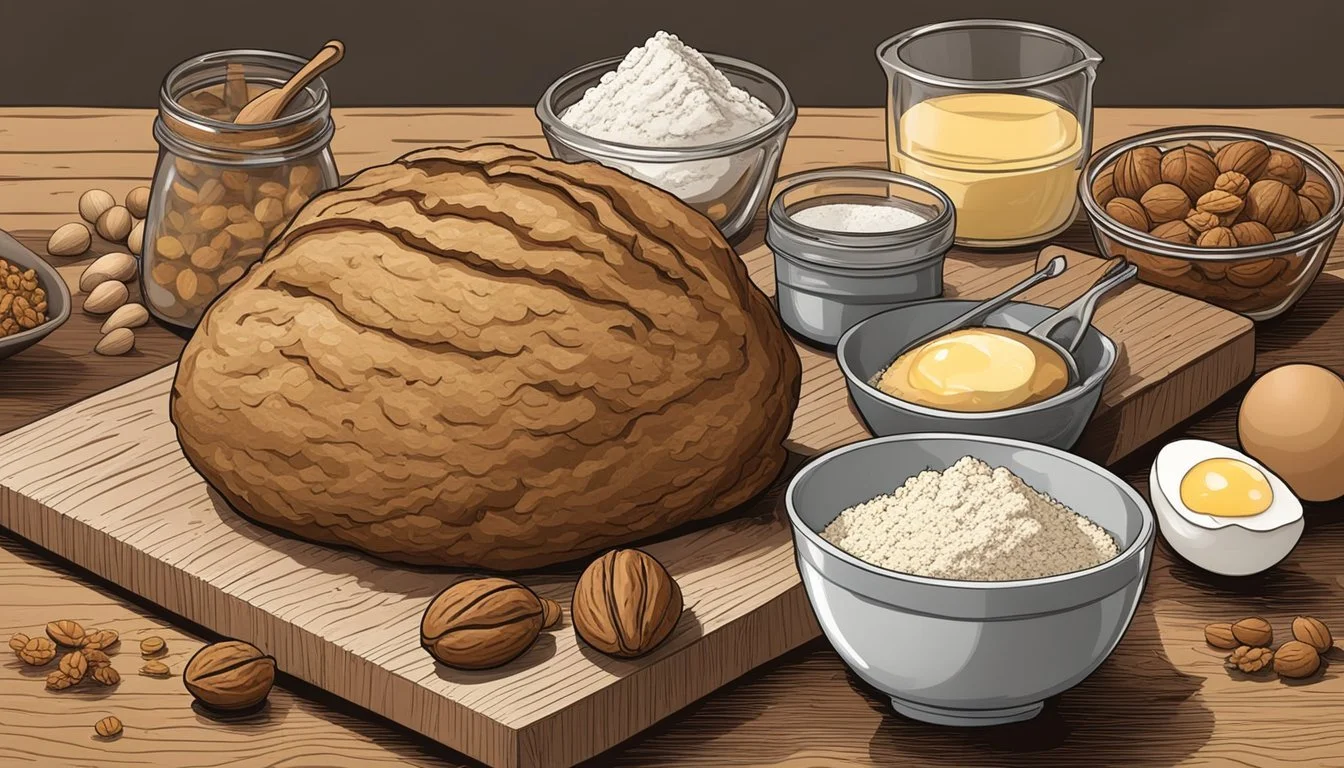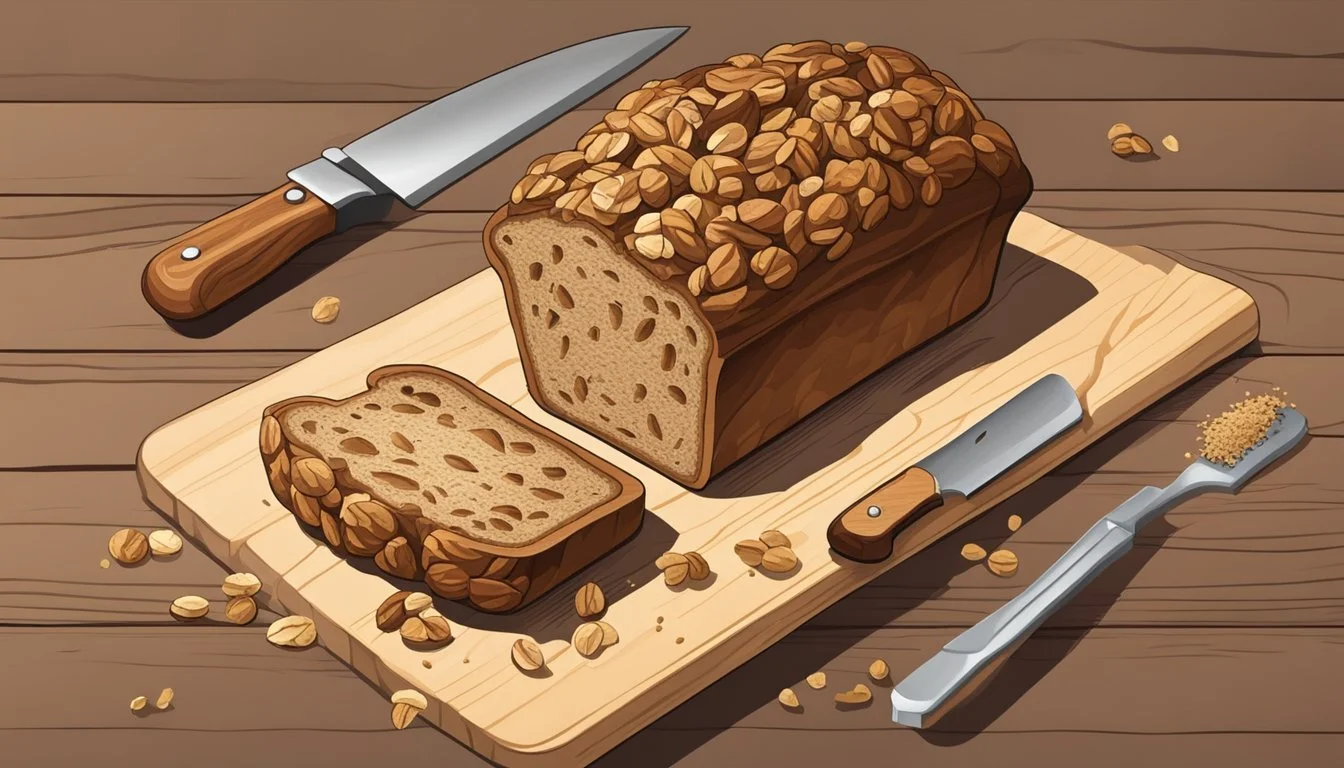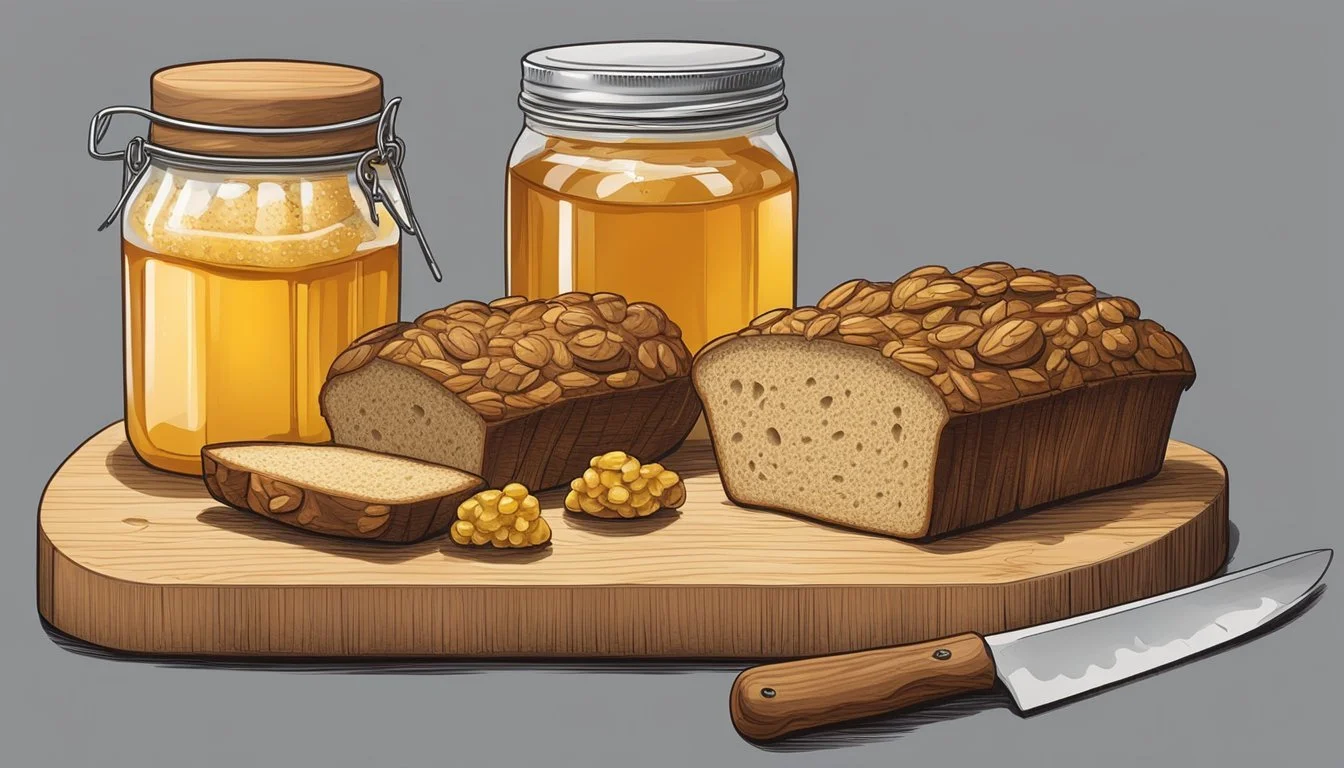How Do You Eat a Walnut Loaf?
Tips for Enjoying This Nutty Bread
Eating a walnut loaf is a delightful experience that marries the rich, nutty flavor of walnuts with the comforting texture of baked bread (What wine goes well with bread?). This versatile treat can be enjoyed in various ways, depending on one's personal taste and the context of the meal. Whether served as a breakfast option, a snack, or as part of a larger spread, the walnut loaf's distinctive taste and texture make it a favorite among those who appreciate rustic, hearty baked goods.
A walnut loaf can be savored plain, with its dense crumb and walnut pieces offering ample flavor and crunch. For those who prefer a bit more indulgence, a spread of butter or a drizzle of honey can enhance the loaf's natural sweetness and complement the earthiness of the nuts. It pairs beautifully with both tea and coffee, providing a satisfying balance to their bitterness. The loaf can also be toasted, which intensifies its flavors and adds a pleasant warmth, making it an excellent choice for colder days or a cozy breakfast.
Ingredients
When creating a walnut loaf, the ingredients play a pivotal role in determining the flavor and texture of the final product. Choosing quality ingredients and preparing them correctly ensures a delightful loaf.
Highlighting Key Ingredients
Walnuts: Integral to the loaf's texture and taste, they lend a rich, nutty flavor.
Flour: Provides the structure; commonly, all-purpose flour is used.
Sugar: Adds sweetness and browns the loaf.
Butter: Contributes to a moist crumb and adds flavor.
Eggs: Act as a binding agent and give the loaf richness.
Milk: Helps to hydrate the dry ingredients and tenderize the crumb.
Vanilla: Offers a warm, aromatic flavor.
Cinnamon: Adds a subtle spiciness and complements the walnuts.
Baking Powder & Baking Soda: These leavening agents ensure the loaf rises properly.
Salt: Balances the flavors and enhances the overall taste.
Oil: Can be used instead of butter to keep the loaf moist.
Preparation of Ingredients
Walnuts should be chopped to the desired size before being added to the batter.
Flour is often sifted with baking powder, baking soda, and salt to ensure even distribution.
Butter should be softened at room temperature for easier creaming with sugar.
Eggs must be fresh and typically beaten prior to incorporation into the mixture.
Milk is best used at room temperature to maintain an even batter temperature.
Vanilla extract is measured and should be pure for the best flavor.
Cinnamon is to be ground finely for a consistent spice throughout the loaf.
Equipment
Proper equipment plays a crucial role in achieving a perfectly baked walnut loaf. Ensuring that one has the right tools on hand before beginning the baking process can make a significant difference in the ease and success of the endeavor.
Choosing the Right Loaf Pan
The selection of a loaf pan is pivotal for the correct shape and baking of a walnut loaf. A standard size for a loaf pan is typically 9x5 inches, optimal for even cooking and providing enough space for the dough to rise without overflowing. For ease of removal and cleanup, lining the loaf pan with parchment paper with an overhang on the sides allows for a quick release after baking.
Material: Pans can be made from various materials such as metal, silicone, or glass, but a metal pan is often recommended for its even heat distribution.
Thickness: A thick-walled pan ensures consistent baking and prevents the exterior of the loaf from burning before the inside is done.
When using the oven, preheating is essential. Set the oven to the recipe's specified temperature, which is commonly set at 350 degrees Fahrenheit for walnut loaves. A baking sheet can be useful if one needs to roast walnuts prior to mixing them into the dough, or to place under the loaf pan in case of any drips or spills during baking.
Walnut Loaf Recipe
Crafting a walnut loaf involves a simple process: preparing a batter infused with the rich taste of walnuts, followed by careful baking to achieve the perfect texture. Precision in following the recipe and baking times ensures a delightful result.
Mixing the Batter
One begins by preheating the oven to 350°F (175°C), which allows time for the batter preparation. In a sizable bowl, whisk together 2 1/2 cups all-purpose flour, 1 cup granulated sugar, 1 tablespoon baking powder, and 1/2 teaspoon salt. In a separate container, cream together 1 cup of milk with 1 egg until well combined. These wet ingredients are then gradually mixed into the dry ingredients, taking care not to overmix as this can affect the loaf's texture.
Baking the Loaf
Upon completion of the batter, it's transferred into a greased and floured loaf pan. The batter is smoothed out, and the pan is then placed into the preheated oven. The typical cooking times range from 50 to 60 minutes. To verify doneness, one can insert a skewer into the center of the loaf; it should come out clean. It's also beneficial to cover the loaf with aluminum foil if over-browning is a concern, particularly if the loaf requires the longer end of the baking time.
Serving Suggestions
Walnut loaf is versatile in its serving options, ideal for various meals from a hearty breakfast to an elegant dessert. Proper accompaniments and presentation are key to enhancing the eating experience.
Accompaniments
Breakfast: For those who prefer it as a breakfast item, walnut loaf pairs exceptionally well with a light spread of buttercream or a dollop of vanilla ice cream for a sweeter start to the day. Additionally, slicing and toasting it elevates the flavors and adds a satisfying crunch.
Afternoon Tea: A slice of walnut loaf serves as an excellent tea-time snack. One might enjoy it plain or with a layer of butter to complement the richness of the nuts.
Dessert: To transform it into a decadent dessert, serve warm with a scoop of vanilla ice cream melting slowly on top, potentially alongside a drizzle of caramel or chocolate sauce to accentuate the loaf's hearty flavors.
Presentation Tips
Slicing: Cut the loaf into even slices to ensure that each piece is visually appealing and cooks evenly when toasted.
Accents: A sprig of mint or a dusting of confectioner's sugar can add an elegant touch if serving walnut loaf as a dessert.
Nutritional Information
A walnut loaf incorporates the rich nutritional profile of walnuts, which contribute valuable dietary components such as fiber, protein, and an array of minerals.
Health Benefits
Walnuts are an excellent source of alpha-linolenic acid (ALA), an essential omega-3 fatty acid that plays a crucial role in reducing inflammation. The presence of fiber in walnuts is beneficial for digestive health and aids in maintaining a healthy microbiome. Moreover, it contributes to feelings of fullness, which can help with weight management.
When considering protein, walnuts add a plant-based boost, which is vital for muscle repair and growth. They also offer a dose of potassium, which is key for maintaining proper heart function and muscle contraction.
Walnuts in the loaf provide minerals such as magnesium and phosphorus, essential for bone health, and copper and manganese, which are involved in several metabolic processes. Regular inclusion of walnuts in one's diet is linked with better heart health due to their potential in improving blood lipid profiles.
Storage and Preservation
When it comes to keeping a walnut loaf fresh, the focus should be on maintaining its moisture and preventing spoilage. Walnut loaf, due to its ingredients, can be prone to drying out or going rancid if not stored correctly.
How to Store
A walnut loaf should be kept in a dry area at room temperature for initial storage. To extend its freshness beyond a day or two, they recommend wrapping the loaf in foil or plastic wrap and placing it in a plastic bag. This method prevents the bread from losing moisture and becoming stale. Additionally, ensure the storage area is away from direct sunlight and any source of heat.
Room Temperature: Wrap in foil or plastic wrap, place in a plastic bag, and store in a dry area away from heat.
Refrigerator: Can be refrigerated when wrapped properly to extend shelf life for several days.
Freezing Tips
Freezing is an excellent preservation method for extending the shelf life of walnut loaf while maintaining its quality. Before freezing, slice the loaf or wrap it as a whole in parchment paper, following it up with a layer of foil or placing it into a freezer-safe bag to avoid freezer burn.
Preparation: Wrap in parchment paper, then foil or a freezer bag.
Duration: A properly wrapped walnut loaf can be stored in the freezer for several months.
By following these storage and preservation tips, one can enjoy a walnut loaf for an extended period while retaining its fresh-baked taste and texture.
Variations and Substitutions
When crafting a walnut loaf, the versatility in ingredients allows for a range of substitutions and add-ins to suit different preferences and dietary needs.
Alternative Ingredients and Add-ins
Nuts: While walnuts are traditional, one can easily substitute almonds or hazelnuts. To do so, replace equal amounts of chopped walnuts with the desired nut.
Sweeteners: If a recipe calls for maple syrup and it's not available, honey or agave can be good alternatives to maintain the moisture and sweetness.
Flour: For those with gluten sensitivities, all-purpose flour can be swapped for a gluten-free blend. Keep the consistency of the loaf in check by adjusting the liquid ingredients if necessary.
Fruits and Vegetables:
Carrot: Finely grated carrot can be added to introduce a subtle sweetness and additional moisture.
Pumpkin: Pureed pumpkin can be a flavorful addition, especially complemented by spices such as cinnamon and nutmeg.
Banana: Mashed banana can serve as a moistening agent, adding a distinct flavor profile and natural sweetness.
Apple: Diced or shredded apple can be incorporated to enhance texture and lend a fruit-forward taste to the loaf.
Spices: Classic spices such as cinnamon, nutmeg, and vanilla are favorites, but one can experiment with cardamom or ginger for a unique twist.
The key to successful substitutions is to maintain the balance of wet and dry ingredients to ensure the loaf retains its desired texture and structure.
Common Questions
In this section, readers can find answers to frequently asked queries about the best ways to enjoy walnut loaf. From serving suggestions to storage tips, the aim is to provide clear and concise advice.
FAQs
Q: How does one serve a walnut loaf?
A: Walnut loaf, often classified as a quick bread, is typically sliced and can be enjoyed with both sweet and savory accompaniments. It makes for an excellent breakfast option when toasted and paired with butter or jam, or as a side for a savory dish such as soup or salad.
Q: Can walnut loaves be eaten as muffins?
A: Certainly. The batter for walnut bread can often be portioned into a muffin tin to create individual walnut muffins. This is a convenient option for single servings and is particularly popular among children.
Q: Is walnut loaf suitable for all ages?
A: Yes, walnut loaf is a versatile bread that people of all ages can enjoy. It's soft and easy to eat, making it suitable for both children and adults.
Q: Does walnut loaf require yeast?
A: Typically, walnut loaf does not require yeast as it falls under the category of quick breads which use baking soda or baking powder as leavening agents.
Q: How should one store a walnut loaf to maintain freshness?
A: Store walnut loaf in an airtight container at room temperature for short-term storage, or wrap well and freeze for long-term. It's best consumed within a few days of baking.
Storage Tips:
Room Temperature: 1-2 days, sealed container
Refrigerate: Not recommended; may dry out bread
Freeze: Up to 3 months, wrapped tightly
Serving Suggestions:
Breakfast: Toasted with butter or fruit preserves
Lunch: As a side to salads or soups
Snack: Slices with cheese or nut butter
Conclusion
In this article, the nuances of consuming a walnut loaf have been meticulously discussed, providing the reader with clear and detailed instructions on enjoying this delightful treat.
Recap and Review
The walnut loaf, a comforting and versatile bread, finds its place in diverse categories ranging from a British tea-time staple to a heartwarming addition to Thanksgiving meals. Its rich, nutty flavor and dense texture have been appreciated in various recipes. They have diligently reviewed the methods for toasting walnuts to enhance their flavor, the importance of correct measuring of ingredients for consistency, and the appropriate techniques for combining these elements to create a perfect loaf.
To embody the pleasurable experience of eating walnut loaf, one must realize that each slice offers a unique blend of sweet and savory tastes, ideal for different times and meals. Whether served warm and buttered, as a vessel for sandwiches, or as an accompaniment to cheeses and fruits, walnut loaf holds a distinctive position in the review as a beloved bakery item.
In summary, the reader has been equipped with the essential knowledge to select, prepare, and savor walnut loaf to its fullest potential, respecting its British origins and recognizing its place at celebratory tables such as those during Thanksgiving.









